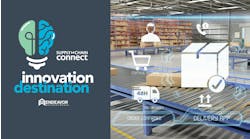Visibility and awareness are desired attributes for all stakeholders throughout the supply chain. In this Executive Perspectives episode, Richie Daigle, Enterprise Account Executive at Tive, shares the technologies being integrated today to achieve supply chain visibility throughout the transportation sector, what it means for procurement professionals and what the future of supply chain visibility technology looks like.
This interview was edited and formatted for clarity.
Tyler Fussner, Managing Editor, Supply Chain Connect
Richie, thank you for joining us today.
Richie Daigle, Enterprise Account Executive, Tive
Thanks for having me, Tyler. It’s a pleasure to be here. Excited about the conversation.
Fussner
If you could please introduce yourself to our audience.
Daigle 0:30
Yeah, my name is Richie Daigle, and I’m an enterprise accounting executive at Tive. I’ve been here at Tive for two years, almost to the day. Prior to that I was at Freight Waves; prior to that I worked in a different industry altogether in travel; and before that I played baseball for a while. And to keep on going back, eventually, I’ll get to birth, which might be a bit boring, but that’s a little bit about me.
Fussner 0:56
Can you tell us a little bit about Tive and what you guys do?
Daigle 1:00
Tive is a visibility solution, which is the high-level boring bit, but more specifically, we help companies understand where their freight is located and the conditions that they’re freight is in, in real time, on any mode of transportation across the world. Our drive as a company is we believe that every shipment matters, and not enough freight arrives on time and in full. We feel that, as a whole industry, we could all do a little bit better. The role that we play is helping people raise their overall awareness of location and conditions, so that they’re better able to take quick actions to save shipments if something goes sideways.
So, that’s a little bit about what we do. Of course, if I talk too long, I can go into a whole bunch of rabbit holes. But at a high level, that’s what we’re all about: helping freight get from point A to point B.
Fussner 1:54
Richie, I’m excited to dive into this conversation with you. The big question I have: What is supply chain visibility? Can you tell me why it’s so important?
Daigle 2:05
That’s the million-dollar question that I think everybody’s still trying to figure out. I think context is everything, because supply chain visibility is a big word; supply chain is a big word. These are big, giant umbrellas. Within supply chain, you have sourcing, procurement, you have materials, you have transportation, you have logistics, warehousing—you have all these different components that are woven together to create a supply chain.
There’s a lot of different types of visibility, depending on which part of the supply chain you’re poking your nose around. You may want to have visibility into where you’re sourcing materials; you may want to have visibility into inventory controls and what’s coming; forecasting and these sorts of things. You may want to have visibility into transportation and where your stuff is located at any point in time. These are all different forms of visibility. What we at Tive focus on is more transportation and to some degree logistics visibility, understanding when freight is in transit. Where is it and what sort of condition is it in?
That’s the niche of visibility that Tive focuses on, but supply chain visibility is a big umbrella that encompasses quite a lot of technology, and quite a lot of various systems and so forth.
Fussner 3:33
I wanted to talk to you about some of those technologies to get that visibility. Can you tell me a little bit about the technologies that are available so that users can access that visibility and transparency in their operations?
Daigle 3:50
What you’re seeing today is, “How can we link all these things together?” Companies are utilizing API and really robust ERP systems as ways to bring in all these disparate sources of niche visibilities to create overall visibility. I think you’re seeing some of that happen in the marketplace or in the market in general, where a lot of companies want to have everything in one place. But there are a lot of different technologies out there.
Getting into transportation-specific, just transportation visibility, there’s a lot of nuances and different types of technologies there. You may have some companies that want to integrate different types of software-based ways of tracking freight, which are mainly going to be based in tracking the assets that are moving freight. We want to track the planes and the vessels and the trucks and so forth that our freight is scheduled to be on or being moved by. A lot of that is possible through ELD, through telematics, through some GPS devices that are hardwired into a trailer, hardwired into a container, or a truck, or a plane or a vessel. These are baseline ways of understanding; ways that companies will understand where something is located at any given point in time. That’s the baseline that we have today for transportation visibility.
The pros to those solutions are that they’re relatively inexpensive on a per-shipment basis and they work most of the time. The cons are that they work most of the time, and not all of the time. Some of these are going to be based on humans that are opting into using a specific app, or that they’re staying compliant with ELD (for truck drivers). There are ways and things that can happen where data distribution can be broken. And if that happens, then that location visibility breaks as well.
Fussner 5:54
It certainly is a big topic. We’re touching on the concept of that visibility; of understanding where things are, what’s happening, where things are taking place, making sure that things are going from A to B. But what are some of the benefits of getting those technologies in place beyond the concept of understanding? Another way to ask that is: What are some hurdles or obstacles that organizations can now overcome since they’ve onboarded such technologies? Does it help solve any issues?
Daigle 6:26
For sure. What you have now, I alluded to this previously, is companies are starting to blend different technologies and different data streams together to create an overall picture. So, what’s possible for companies now is to build a tech stack that is specific to visibility. You can even build a tech stack that is specific to transportation visibility.
If you’re a large company, let’s say you’re a fortune 50, fortune 100 company, not all of your shipments are going to be the same. You may have some truckload or full container shipments that have a value of $10,000. You may have some truckload shipments, or full container shipments of a value of $10 million, and a lot of things in between. You may have very sensitive freight; freight that’s a high risk or sensitive to temperature, or both, or very sensitive to shock. You may have some freight that’s very resilient, no one’s going to steal this, doesn’t matter if it gets hot or cold, it can get knocked around, that’s fine. Doesn’t have to be super on-time, there’s no rush here. So now companies are able to match the right technology to the right freight. You might want to utilize one of the software-based visibility providers for your baseline for understanding. Like, “Let’s deploy this across all of our freight as our baseline for track and trace and understanding location and having that real time visibility. And then maybe we want to layer an IoT device, like Tive, on top for a subset of freight that we need to know, we can’t take any chances on its location. Plus, it’s a theft risk.” Meaning location plus a condition. Either it’s a theft risk or it’s temperature sensitive or there’s concerns about impact and shock or humidity or something like that.
Now companies are able to layer that in only for the types of freight where that makes sense, have all that data come in via API into one dashboard along with the rest of their visibility that’s coming from their baseline provider, and have everything buttoned up in a in a nice visual right there in front of them to work with. That’s the type of technology that’s available. You have all of those different components, you have the baseline technologies, there are several companies out there doing that, there are IoT companies like Tive, and there are a lot of different platforms where you can marry all that data and have it live in one place.
Listen to the rest of the episode on the podcast player above or below, or wherever you listen to podcasts, picking up at the 8:55 mark!









